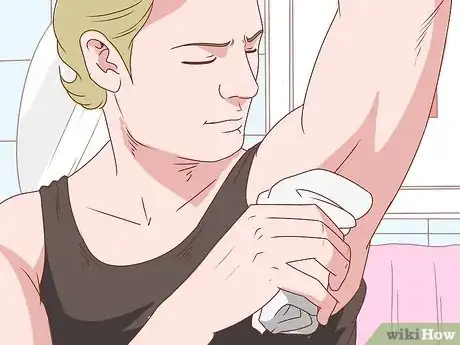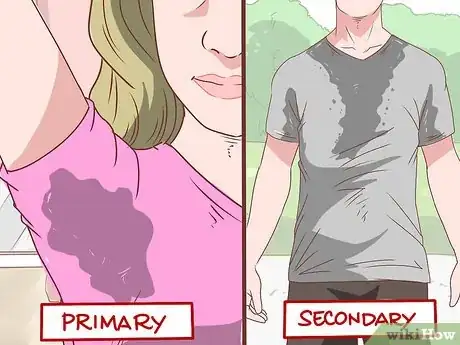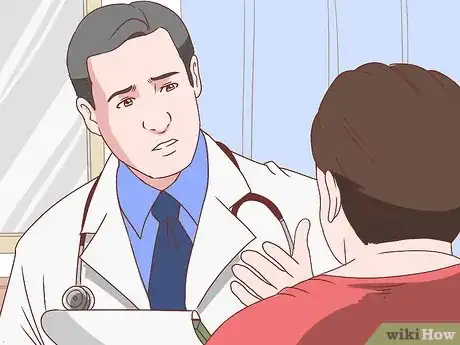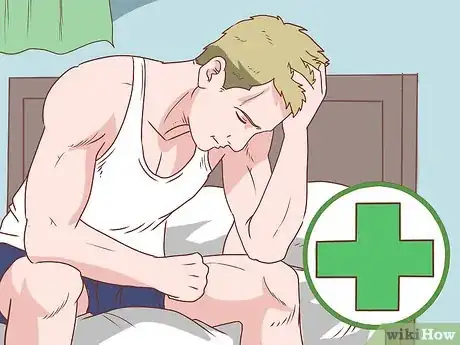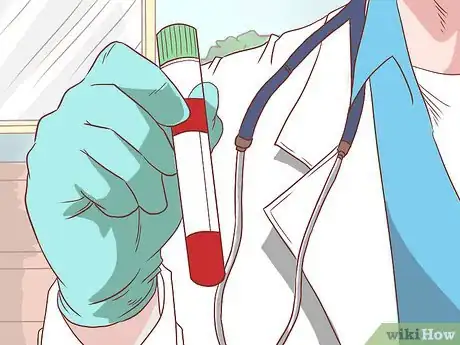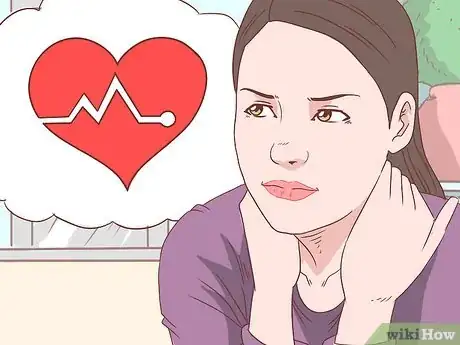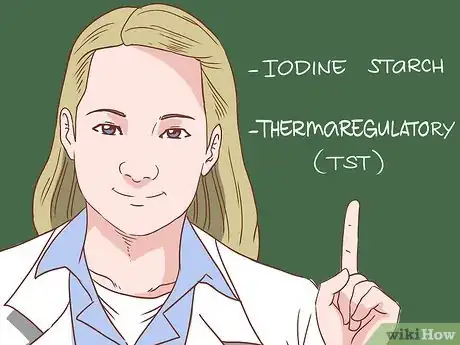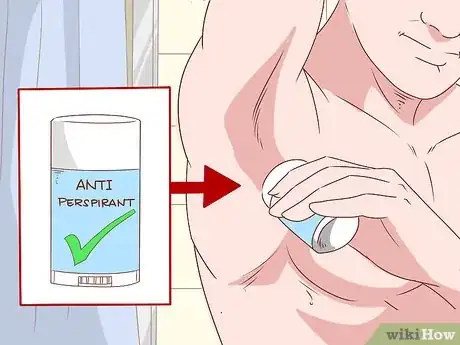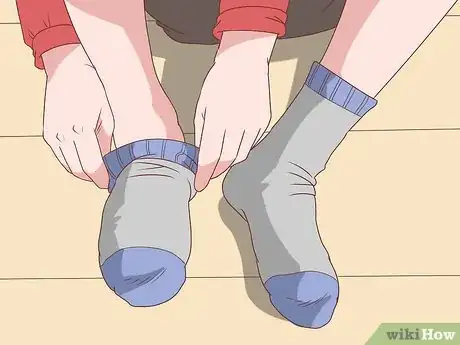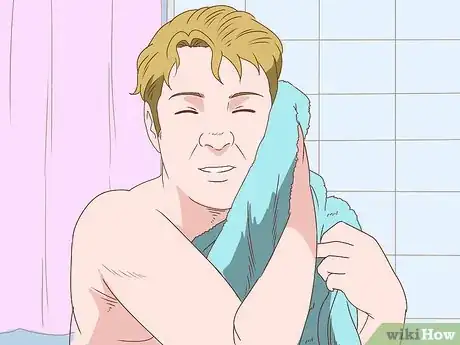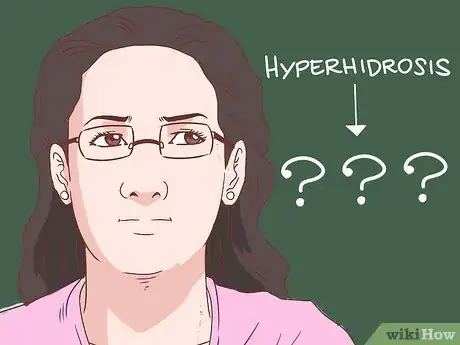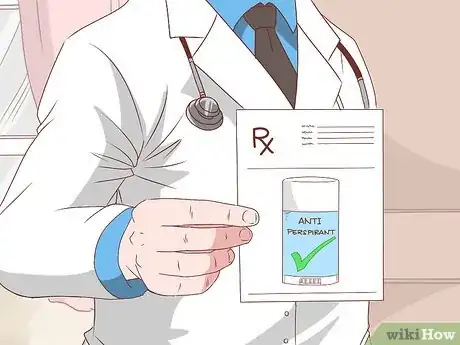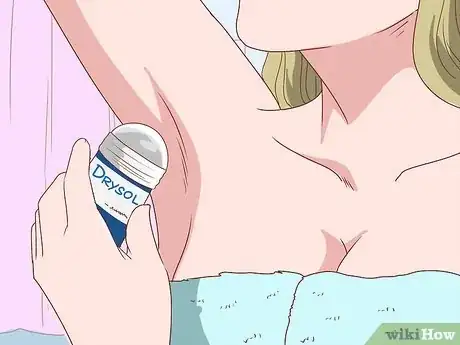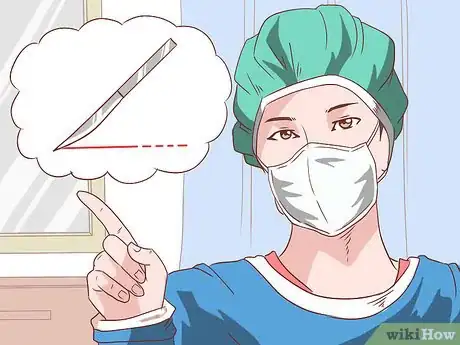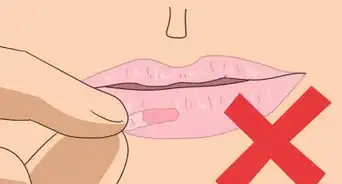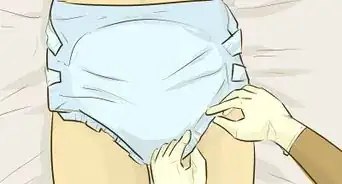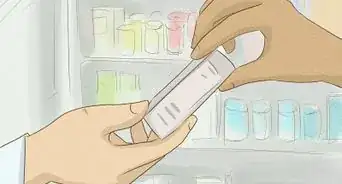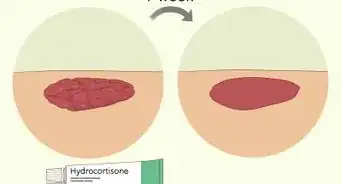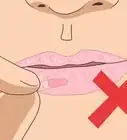This article was co-authored by Chris M. Matsko, MD. Dr. Chris M. Matsko is a retired physician based in Pittsburgh, Pennsylvania. With over 25 years of medical research experience, Dr. Matsko was awarded the Pittsburgh Cornell University Leadership Award for Excellence. He holds a BS in Nutritional Science from Cornell University and an MD from the Temple University School of Medicine in 2007. Dr. Matsko earned a Research Writing Certification from the American Medical Writers Association (AMWA) in 2016 and a Medical Writing & Editing Certification from the University of Chicago in 2017.
There are 14 references cited in this article, which can be found at the bottom of the page.
This article has been viewed 26,494 times.
Hyperhidrosis is a neurological disorder that causes excessive sweating completely independent of heat, stressful situations, or feeling nervous. People who suffer from hyperhidrosis typically fall into one of two categories: those that experience excessive sweating regularly for an extended period of their lives, or those who have excessive sweating caused by a different medical condition or medication. Hyperhidrosis is not simply sweating a lot; it’s sweating so much that it causes significant issues in the lives of those who suffer it.
Steps
Recognizing the Symptoms of Hyperhidrosis
-
1Look for abnormal sweating. Sweating is a completely normal process and an important way your body maintains a consistent temperature. However, if you find that you sweat much more often than seems appropriate, you may have hyperhidrosis.[1]
- Hyperhidrosis causes sweating in the absence of physical activity or stress.
- Sweating when your body is not actively trying to regulate your body temperature is the number one symptom of hyperhidrosis.
-
2Take note if your sweating affects you socially. A common sign that a person suffers from hyperhidrosis is when excessive sweating begins to cause problems in your everyday life. Many people with hyperhidrosis struggle with the issue on a daily basis.[2]
- If you find yourself needing to change your clothes throughout the day in order to hide your excessive sweating, you may suffer from hyperhidrosis.
- Having to do things like stuffing napkins under your arms or excusing yourself to the bathroom to wipe off excess sweat in comfortable environments is not common and may be a sign of hyperhidrosis.
-
3Identify primary and secondary hyperhidrosis. Primary hyperhidrosis is excess sweating that exists independently from any other medical condition. If your body simply sweats to excess, you likely have primary hyperhidrosis. Secondary hyperhidrosis occurs when your body is sweating excessively as a result of, or as a symptom of, another medical condition.[3]
- Primary hyperhidrosis often affects certain areas of the body that are referred to as “focal points” like armpits or hands.
- Secondary hyperhidrosis is often more generalized. A common example of secondary hyperhidrosis is excessive night sweating from your entire body.
-
4Determine which form of hyperhidrosis you have. It is important to determine if you are suffering from primary or secondary hyperhidrosis in order to effectively treat the condition. You should make an appointment with your doctor to discuss your circumstances, but there are some questions you can ask yourself to help you identify which form of hyperhidrosis you seem to be suffering. If you meet any two of the following criteria, you likely have primary hyperhidrosis. If not, your sweating issues are likely secondary in nature.[4]
- Your sweating is fairly symmetrical (you sweat the same from each side of your body).
- You experience at least one episode of excessive sweating per week.
- Your excess sweating impairs your regular activities.
- Your issues with excess sweating began before the age of 25.
- Primary hyperhidrosis runs in your family.
- You do not have excessive sweat issues when you are sleeping.
-
5Seek immediate medical attention if necessary. If you are taking an inventory of your excessive sweating symptoms and you notice some common warning signs of a significant medical issue, seek medical attention as quickly as you can.[5]
- Seek medical attention if you have a fever that reaches 104 °F (40 °C) or higher.
- If you experience shortness of breath, lightheadedness, or chest pain, seek treatment immediately.
Testing for Hyperhidrosis
-
1Get tested for causes of hyperhidrosis. Even if your symptoms match the criteria for primary hyperhidrosis, you doctor will likely want to conduct a blood test to check for other medical conditions or medications that could be causing your problems. Even if you do have primary hyperhidrosis, it’s possible that a medical condition or medication is exacerbating your condition.[6]
- A blood test can help determine if there is another medical condition or medication in your body that is causing or worsening your hyperhidrosis.
- Urine tests can also help identify toxins in your body that are known causes for hyperhidrosis.
-
2Check to see if your medications cause hyperhidrosis. If you are taking a prescription medication as treatment for a different condition, you should check to see if hyperhidrosis or excessive sweating is a common side effect of the medication.[7]
- An extensive list of medications that are known to cause secondary hyperhidrosis can be found here: http://www.sweathelp.org/pdf/drugs_2009.pdf
- Ask your doctor if excessive sweating is a common side effect of any medication you have been taking.
-
3Check to see if you have a condition that causes hyperhidrosis. It may be possible that you have already been diagnosed with a medical condition that can cause secondary hyperhidrosis. There are a number of ailments that could cause excessive sweating. If you are being treated for any kind of medical condition, ask your doctor is hyperhidrosis is a possible symptom of your illness.[8]
- There are many medical conditions that may cause someone to sweat excessively. If you are suffering from one of these ailments, your treatment options will likely be different than if you suffer only from excessive sweating.
- An extensive list of medical conditions that can cause hyperhidrosis can be found here: http://www.sweathelp.org/pdf/Diseases_2009.pdf
-
4Determine the severity and location of your symptoms. Your doctor will likely conduct a series of sweat tests to identify the extent of your hyperhidrosis and the parts of your body that are most effected by the condition. Primary hyperhidrosis often affects only certain parts of your body, so it’s important to identify the areas that are most in need of treatment.[9]
- An iodine-starch test is conducted by applying a layer of iodine to your body, followed by a dusting of a starch powder. You are then encouraged to exercise or enter a sauna to begin sweating. Areas of excess sweating will allow the iodine to mix with the starch and create different shades of colors based on the severity of your sweating.
- A thermoregulatory sweat test (TST) is conducted in a climate controlled room by changing the temperature and humidity levels and allowing your doctor to view your body’s response to environmental fluctuations.[10]
-
5Keep a sweat journal. Your doctor may also ask you to keep a log of your sweating issues over a period of time so they can better appreciate the extent of your problem and determine an appropriate course of treatment. Keeping a journal can help make sure you don’t forget important elements of your experience if your next appointment isn’t for a little while. Keep track of the following things in your sweat journal:[11]
- The location of your excess sweating: is it localized to certain areas, general sweating over your entire body, or different at different times?
- The time you sweat excessively: do you find that your excess sweat only occurs while doing certain things or at certain times of day? Make note of whether or not you sweat more during the day than at night, for instance.
- Things that trigger your excessive sweating: does stress or anxiety make your sweating worsen? Are there things you tend to be around when sweating becomes an issue? This information can help determine a treatment plan.
- Any other symptoms: make sure to make note of anything else that relates to your sweat issues so the doctor can take all of your symptoms into account.
Treating Hyperhidrosis at Home
-
1Use an antiperspirant. Minor hyperhidrosis can often be treated using over the counter antiperspirant deodorants. Deodorants that say “antiperspirant” on the label are engineered to prevent your body from producing sweat and can be effective if your sweating issues are manageable.[12]
- Antiperspirant deodorants contain aluminum based compounds that temporarily block sweat producing pores, reducing the amount of sweat that leaves your skin.
- Most antiperspirants also help manage the smell created by bacteria in your sweat, reducing issues with body odor.
-
2Change your shoes and socks often. Feet are a common focal point for people with primary hyperhidrosis, and the excess sweating on your feet can cause both odor and medical complications for your feet.[13]
- Try using shoes and socks made from natural materials, as they will not seal the moisture into your foot and will allow your feet to breathe.
- Rotate your shoes so they have a chance to dry between times you wear them to prevent fungal infections like athlete’s foot.
- Change your socks periodically throughout the day if you find that you have sweat through them.
- Try wearing socks made out of merino wool or polypro that such moisture away from the feet.[14]
-
3Maintain good hygiene habits. Excessive sweating can lead to social anxiety caused by visible sweat stains and concerns over body odor. If your hyperhidrosis is affected by your stress or anxiety levels, this can make the problem worse. Exercising good hygiene habits can help reduce your stress, thereby possibly reducing your symptoms.[15]
- Bathe daily to prevent body odor from becoming an issue.
- Make sure to dry yourself completely after you bathe.
- Use and antibacterial soap to control control the bugs that inhabit your sweaty skin and cause odor. Make sure that you dry off completely before you put on antiperspirant.[16]
- Wear light fitting clothing fitting clothing including cotton and silk. If you are exercising make sure that you bring extra clothes. Avoid wearing heavy clothes that trap sweat.[17]
Getting Medical Care for Hyperhidrosis
-
1Adjust your medications. If you are currently taking a medication that is known to cause hyperhidrosis in some patients as a side effect, there may be alternate medications your doctor can prescribe instead. Make an appointment with your doctor to discuss changes to your prescriptions to reduce or prevent excessive sweating.[18]
- Many anti-depressant and anti-anxiety drugs have been known to cause secondary hyperhidrosis. Your doctor may be able to prescribe a different drug that works in a similar fashion but won’t create excessive sweating issues.
- It’s important to discuss changes to your prescription medication with your doctor. Do not stop taking a prescribed medication without meeting with your doctor first.
-
2Treat conditions that may cause excessive sweating. If you have identified your hyperhidrosis to be a secondary issue caused by a different medical condition, you may be able to relieve your excess sweating simply by treating the primary condition effectively.[19]
- Some illnesses that cause hyperhidrosis are easily treatable. Treatment can alleviate your excess sweat as well as other symptoms caused by the primary illness.
- You may need to utilize hyperhidrosis specific treatments in conjunction with other treatments in order to alleviate your symptoms.
-
3Use prescription antiperspirant. If antiperspirants from the store are not enough to limit the amount of sweat your body produces, your doctor may give you a prescription strength antiperspirant. This form of antiperspirant usually contains a large amount of aluminum chloride.[20]
- Prescription antiperspirant is usually a more effective treatment for secondary hyperhidrosis and is applied before bed for night sweating.
- The intervals between application can be gradually increased once a response is noted. Once weekly therapy is typically need for maintenance therapy.[21]
- Prescription antiperspirants can cause skin irritation. If you experience irritated skin using it, wash it off your body and apply hydrocortisone cream to ease the irritation. Then make an appointment with your doctor to discuss possible alternative methods.
-
4Have your doctor prescribe nerve blocking medications. There are medications designed specifically to stifle your body’s production of sweat. Using these medications can be dangerous, as sweat production is an important means of regulating your body’s temperature. If you are prescribed these medications, it’s important that you pay attention to your body temperature and avoid getting overheated.[22]
- Possibly side effects of medications that block communications to your sweat glands can be blurred vision or dry mouth.
- Common medications of this type, such as Hypercare and Drysol, work most effectively for primary hyperhidrosis that affect focal points like the face.
- Other medications used for the systemic treatment of excessive sweating include anticholinergics. These medications are used after other measures like iontophoresis and botox injections are infective. These medication do not come without significant side effect profiles so it is important to discuss these effects with your doctor.
-
5Get iontophoresis. This is the process of applying an electrical current to the area of hyperhidrosis, and has been shown to be effective in clinical trials. It is especially used in palmar and plantar hyperhidrosis. During this treatment you will place your hands for feet in water for 20-30 minutes, while a low electrical current is passing through the water. Data from randomized trials have shown improvement in approximately 85 percent of patient with palmar and plantar hyperhidrosis. Further it is safe and simple to perform. Caution, however, should be taken in those who are pregnant or have pacemakers.[23] [24]
-
6Get botox injections. Botulinum toxin type A (Botox) is commonly thought of as a means to smooth out skin wrinkles, but it can also be used to block the nerves that trigger sweating. Like medications that block these nerves, botox injections can prevent your sweat glands from receiving the message to begin producing sweat.[25]
- Botox injections are commonly used for focal points like the armpit, and as such tend to be used for primary hyperhidrosis.
- Side effects include soreness at the injection site or flu-like symptoms that include being tired and feeling weak.
-
7Undergo surgery. In some serious cases of either primary or secondary hyperhidrosis, your doctor may feel that surgery is necessary to stifle your body’s sweat production. These procedures sever the link between sweat nerves and your sweat glands so your sweat glands do not receive the message to produce sweat from your brain.[26]
- Sympathectomy is a minimally invasive surgery in which doctors literally cut the connection between the nerves that signal to your sweat glands to sweat excessively. This is permanent procedure and used primarily for excessive sweating of the palms or face.
- Excessive under-arm sweating is treated surgically by actually removing the sweat glands under your arms.
- Discuss any surgical options with your doctor to see if they are right for you.
References
- ↑ https://www.aad.org/public/diseases/dry-sweaty-skin/hyperhidrosis
- ↑ http://www.sweathelp.org/home/diagnosing-hyperhidrosis.html
- ↑ http://www.sweathelp.org/home/types-of-hyperhidrosis.html
- ↑ http://www.sweathelp.org/home/types-of-hyperhidrosis.html
- ↑ http://www.mayoclinic.org/diseases-conditions/hyperhidrosis/basics/symptoms/con-20030728
- ↑ http://www.mayoclinic.org/diseases-conditions/hyperhidrosis/basics/tests-diagnosis/con-20030728
- ↑ http://www.sweathelp.org/pdf/drugs_2009.pdf
- ↑ http://www.sweathelp.org/pdf/Diseases_2009.pdf
- ↑ http://www.mayoclinic.org/diseases-conditions/hyperhidrosis/basics/tests-diagnosis/con-20030728
- ↑ https://stanfordhealthcare.org/medical-tests/t/tst.html
- ↑ https://www.nlm.nih.gov/medlineplus/ency/article/007259.htm
- ↑ http://www.mayoclinic.org/diseases-conditions/hyperhidrosis/basics/lifestyle-home-remedies/con-20030728
- ↑ http://www.mayoclinic.org/diseases-conditions/hyperhidrosis/basics/lifestyle-home-remedies/con-20030728
- ↑ http://www.webmd.com/skin-problems-and-treatments/hyperhidrosis-treatment-11?page=2
- ↑ http://www.mayoclinic.org/diseases-conditions/hyperhidrosis/basics/lifestyle-home-remedies/con-20030728
- ↑ http://www.webmd.com/skin-problems-and-treatments/hyperhidrosis-treatment-11?page=2
- ↑ http://www.webmd.com/skin-problems-and-treatments/hyperhidrosis-treatment-11?page=2
- ↑ http://www.mayoclinic.org/diseases-conditions/hyperhidrosis/basics/treatment/con-20030728
- ↑ http://www.sweathelp.org/home/types-of-hyperhidrosis.html
- ↑ http://www.mayoclinic.org/diseases-conditions/hyperhidrosis/basics/treatment/con-20030728
- ↑ https://www.uptodate.com/contents/primary-focal-hyperhidrosis?source=search_result&search=hyperhidrosis&selectedTitle=1~150#H706303603
- ↑ http://www.mayoclinic.org/diseases-conditions/hyperhidrosis/basics/treatment/con-20030728
- ↑ https://www.uptodate.com/contents/primary-focal-hyperhidrosis?source=search_result&search=hyperhidrosis&selectedTitle=1~150#H706303603
- ↑ http://www.webmd.com/skin-problems-and-treatments/hyperhidrosis-treatment-11?page=2
- ↑ https://www.nlm.nih.gov/medlineplus/ency/article/007259.htm
- ↑ https://www.nlm.nih.gov/medlineplus/ency/article/007259.htm

